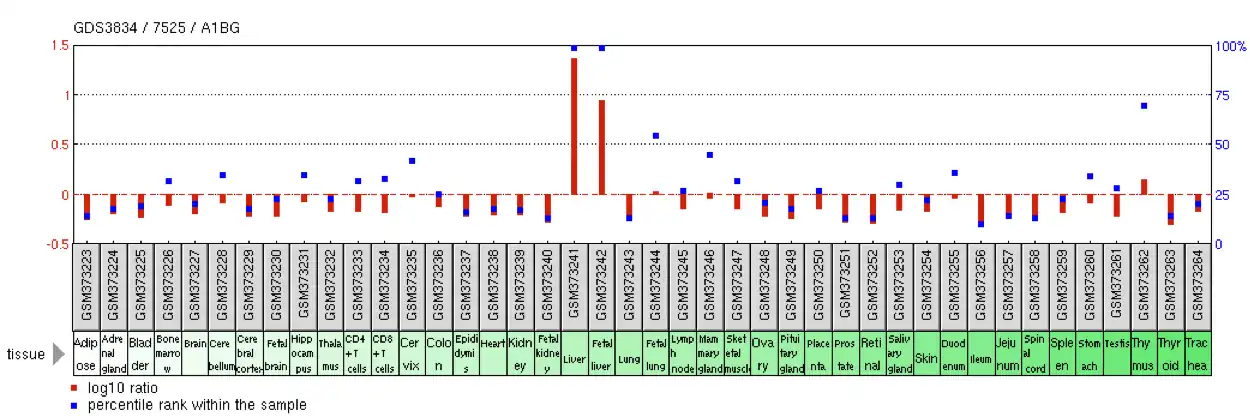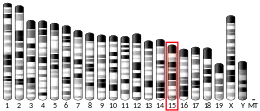Alpha-1-B glycoprotein
Alpha-1-B glycoprotein is a 54.3 kDa protein in humans that is encoded by the A1BG gene. [5] The protein encoded by this gene is a plasma glycoprotein of unknown function. The protein shows sequence similarity to the variable regions of some immunoglobulin supergene family member proteins. Patients who have pancreatic ductal adenocarcinoma show an overexpression of A1BG in pancreatic juice.[6]
| A1BG | |||||||||||||||||||||||||||||||||||||||||||||||||||
|---|---|---|---|---|---|---|---|---|---|---|---|---|---|---|---|---|---|---|---|---|---|---|---|---|---|---|---|---|---|---|---|---|---|---|---|---|---|---|---|---|---|---|---|---|---|---|---|---|---|---|---|
| Identifiers | |||||||||||||||||||||||||||||||||||||||||||||||||||
| Aliases | A1BG, A1B, ABG, GAB, HYST2477, alpha-1-B glycoprotein | ||||||||||||||||||||||||||||||||||||||||||||||||||
| External IDs | OMIM: 138670 MGI: 2152878 HomoloGene: 11167 GeneCards: A1BG | ||||||||||||||||||||||||||||||||||||||||||||||||||
| |||||||||||||||||||||||||||||||||||||||||||||||||||
| |||||||||||||||||||||||||||||||||||||||||||||||||||
| |||||||||||||||||||||||||||||||||||||||||||||||||||
| |||||||||||||||||||||||||||||||||||||||||||||||||||
| |||||||||||||||||||||||||||||||||||||||||||||||||||
| Wikidata | |||||||||||||||||||||||||||||||||||||||||||||||||||
| |||||||||||||||||||||||||||||||||||||||||||||||||||
Gene
Neighborhood
A1BG is located on the negative DNA strand of chromosome 19 from 58,858,172 – 58,864,865.[7] Additionally, A1BG is located directly adjacent to the ZSCAN22 gene (58,838,385-58,853,712) on the positive DNA strand, as well as the ZNF837 (58,878,990 - 58,892,389, complement) and ZNF497 (58865723 - 58,874,214, complement) genes on the negative strand.[7]
Expression

A1BG is expressed at high levels in the adult and fetal liver.[8] Additionally, the mammary gland shows roughly half as much expression as the liver.[8] Trace amounts of A1BG expression can be found in the blood, brain, lung, lymph node, ovary, testis, pancreas, and pancreas.[8] Liver tumors exhibit elevated levels of A1BG transcripts.[8]
mRNA
mRNA structure
The gene contains 20 distinct introns.[9] Transcription produces 15 different mRNAs, 10 alternatively spliced variants and 5 unspliced forms.[9] There are 4 probable alternative promoters, 4 non overlapping alternative last exons and 7 validated alternative polyadenylation sites.[9] The mRNAs appear to differ by truncation of the 5' end, truncation of the 3' end, presence or absence of 4 cassette exons, overlapping exons with different boundaries, splicing versus retention of 3 introns.[9]
Protein
Properties
The San Diego Super Computer's Statistical Analysis of Protein (SAPS) program determined that alpha-1B glycoprotein has 495 amino acids residues, an isoelectric point of 5.47, and a molecular mass of 54.3 kDa. Additionally, it suggested that no transmembrane domains exist in alpha-1B glycoprotein.[10] According to NCBI, the amino acid sequence MLVVFLLLWGVTWGPVTEA is a signal peptide on the N-terminus of the protein that might function as an endoplasmic reticulum import signal.[10]
Post-translational modifications
The NetAcet 1.0 program calculated that the first five amino acid residues serve as an N-acetylation site.[11] The NetGlycate 1.0 program predicted that the lysines located at residue 78, 114, and 227 serve as glycation points.[12] The NetNES 1.1 program predicted the leucine at residue 47 to be a nuclear export signal.[13] The NetNGlyc 1.0 program predicted four N-glycosylation sites - two of which are highly conserved internally repeated sequences.[14][15] The NetCGlyc1.0 program predicted that none of the tryptophan residues serve as C-mannosylation sites.[16]
Protein interactions
A study by Udby et al. showed that Cysteine-rich secretory protein 3 is a ligand of alpha-1B glycoprotein in human plasma and they suggest that the A1BG-CRISP-3 complex displays a similar function in protecting the circulation from a potentially harmful effect of free CRISP-3.[17]
Sex-specific role in cardiac function
Female mice with cardiac conditional knockout of A1BG exhibit poor cardiac function, but male mice with the same knockout are unaffected.[18]
Homology
Orthologs
In addition to the table below, alpha-1B glycoprotein is also conserved in the white-cheeked crested gibbon, baboon, bolivian squirrel monkey, sheep, dog, wild boar, Chinese tree shrew, Chinese hamster, black flying fox, rabbit, guinea pig, giant panda, cow, rat, and the naked mole-rat.[19] Additionally, it is very likely that A1BG is further conserved throughout the mammalian clade.
| Genus species | Organism common name | Divergence from humans (MYA) [20] | NCBI protein accession number | Sequence identity | Protein length | Common gene name |
|---|---|---|---|---|---|---|
| Homo sapiens[21] | Human | -- | NP_570602 | 100% | 495 | A1BG |
| Pan troglodytes[22] | Chimpanzee | 6.2 | XP_001146669 | 97.0% | 501 | PREDICTED: Alpha-1B-glycoprotein isoform 4 |
| Pan paniscus[23] | Bonobo | 6.3 | XP_003816677 | 97.0% | 499 | A1BG |
| Gorilla gorilla gorilla [24] | Gorilla | 8.8 | XP_004061652 | 95.0% | 275 | PREDICTED: alpha-1B-glycoprotein |
| Pongo pygmaeus[25] | Orangutan | 15.7 | XP_002829953 | 95.0% | 495 | alpha-1B-glycoprotein isoform 1 |
| Macaca mulatta[26] | Rhesus monkey | 29.0 | XM_001101821 | 88.0% | 351 | hypothetical protein EGK_11172, partial |
| Callithrix jacchus[27] | Marmoset | 42.6 | XP_002762619 | 83.0% | 500 | A1BG |
| Mus musculus [28] | Mouse | 91.0 | NP_001074536 | 44.0% | 512 | alpha-1B-glycoprotein precursor |
| Felis catus[29] | Cat | 94.2 | XP_003997399 | 62.0% | 481 | PREDICTED: alpha-1B-glycoprotein |
| Equus caballus[30] | Horse | 97.4 | XP_001495344 | 58.0% | 568 | PREDICTED: alpha-1B-glycoprotein-like |
| Loxodonta africana [31] | African bush elephant | 104.7 | XP_003406722 | 61.0% | 520 | PREDICTED: alpha-1B-glycoprotein-like |
Homologous domains
An initial NCBI Blast alignment of alpha-1B glycoprotein illustrates that the protein is mainly composed of three immunoglobulin domains.[33] There is a large segment of amino acids from position 297 to 400 that is not shown to be an immunoglobulin domain. However, a NCBI BLAST alignment of just the amino acids from 297 to 400 does illustrate that the latter sequence is indeed a fourth immunoglobulin domain.[34] Ultimately, alpha-1B glycoprotein seems to be primarily composed of four immunoglobulin domains.
Clinical significance
Steroid-resistant nephrotic syndrome
The alpha-1-glycoprotein is upregulated 11-fold in the urine of patients who have steroid resistant nephrotic syndrome.[35] A1BG was present in 7/19 patients with SRNS and was absent from all patients with steroid sensitive nephrotic syndrome.[35] The 13.8 kDa A1BG fragment had a high discriminatory power for steroid resistance in pediatric nephrotic syndrome, but is only present in a subset of patients.[35]
References
- GRCh38: Ensembl release 89: ENSG00000121410 - Ensembl, May 2017
- GRCm38: Ensembl release 89: ENSMUSG00000022347 - Ensembl, May 2017
- "Human PubMed Reference:". National Center for Biotechnology Information, U.S. National Library of Medicine.
- "Mouse PubMed Reference:". National Center for Biotechnology Information, U.S. National Library of Medicine.
- "Entrez Gene: Alpha-1-B glycoprotein". Retrieved 2012-11-09.
- Tian M, Cui YZ, Song GH, Zong MJ, Zhou XY, Chen Y, Han JX (2008). "Proteomic analysis identifies MMP-9, DJ-1 and A1BG as overexpressed proteins in pancreatic juice from pancreatic ductal adenocarcinoma patients". BMC Cancer. 8: 241. doi:10.1186/1471-2407-8-241. PMC 2528014. PMID 18706098.
- "A1BG alpha-1-B glycoprotein". Retrieved May 10, 2013.
- "EST Profile - Hs.529161". UniGene. National Center for Biotechnology Information, U.S. National Library of Medicine. Retrieved 2013-05-11.
- "AceView: A1BG". Retrieved May 11, 2013.
- Brendel V, Bucher P, Nourbakhsh IR, Blaisdell BE, Karlin S (March 1992). "Methods and algorithms for statistical analysis of protein sequences". Proc. Natl. Acad. Sci. U.S.A. 89 (6): 2002–6. Bibcode:1992PNAS...89.2002B. doi:10.1073/pnas.89.6.2002. PMC 48584. PMID 1549558.
- Kiemer L, Bendtsen JD, Blom N (April 2005). "NetAcet: prediction of N-terminal acetylation sites". Bioinformatics. 21 (7): 1269–70. doi:10.1093/bioinformatics/bti130. PMID 15539450.
- Johansen MB, Kiemer L, Brunak S (September 2006). "Analysis and prediction of mammalian protein glycation". Glycobiology. 16 (9): 844–53. CiteSeerX 10.1.1.128.831. doi:10.1093/glycob/cwl009. PMID 16762979.
- la Cour T, Kiemer L, Mølgaard A, Gupta R, Skriver K, Brunak S (June 2004). "Analysis and prediction of leucine-rich nuclear export signals". Protein Eng. Des. Sel. 17 (6): 527–36. doi:10.1093/protein/gzh062. PMID 15314210. Retrieved May 10, 2013.
- Gupta, R. "Prediction of N-glycosylation sites in human proteins". Retrieved May 10, 2013.
- Higgins DG, Bleasby AJ, Fuchs R (April 1992). "CLUSTAL V: improved software for multiple sequence alignment". Comput. Appl. Biosci. 8 (2): 189–91. doi:10.1093/bioinformatics/8.2.189. PMID 1591615.
- Julenius, Karin (2007). "NetCGlyc1.0: Prediction of mammalian C-mannosylation sites". Glycobiology. 17 (8): 868–876. doi:10.1093/glycob/cwm050. PMID 17494086. Retrieved May 10, 2013.
- Udby L, Sørensen OE, Pass J, Johnsen AH, Behrendt N, Borregaard N, Kjeldsen L (October 2004). "Cysteine-rich secretory protein 3 is a ligand of alpha1B-glycoprotein in human plasma". Biochemistry. 43 (40): 12877–86. doi:10.1021/bi048823e. PMID 15461460.
- Shi, Wei; Sheng, Xinlei; Dorr, Kerry M.; Hutton, Josiah E.; Emerson, James I.; Davies, Haley A.; Andrade, Tia D.; Wasson, Lauren K.; Greco, Todd M.; Hashimoto, Yutaka; Federspiel, Joel D. (October 2021). "Cardiac proteomics reveals sex chromosome-dependent differences between males and females that arise prior to gonad formation". Developmental Cell. 56 (21): 3019–3034.e7. doi:10.1016/j.devcel.2021.09.022. PMC 9290207. PMID 34655525.
- "NCBI Blast results for A1BG protein sequence". Retrieved May 11, 2013.
- "Time Tree".
- "alpha-1-B glycoprotein [Homo sapiens]". Retrieved May 11, 2013.
- "PREDICTED: alpha-1B-glycoprotein isoform 4 [Pan troglodytes]". NCBI. Retrieved May 10, 2013.
- "PREDICTED: alpha-1B-glycoprotein [Pan paniscus]". Retrieved May 11, 2013.
- "PREDICTED: alpha-1B-glycoprotein". Retrieved May 10, 2013.
- "Send to: PREDICTED: alpha-1B-glycoprotein isoform 1 [Pongo abelii]". Retrieved May 11, 2013.
- "hypothetical protein EGK_11172, partial [Macaca mulatta]". Retrieved May 11, 2013.
- "PREDICTED: alpha-1B-glycoprotein [Callithrix jacchus]". Retrieved May 11, 2013.
- "alpha-1B-glycoprotein precursor [Mus musculus]". Retrieved May 11, 2013.
- "PREDICTED: alpha-1B-glycoprotein [Felis catus]". Retrieved May 11, 2013.
- "PREDICTED: alpha-1B-glycoprotein-like". Retrieved May 11, 2013.
- "PREDICTED: alpha-1B-glycoprotein-like [Loxodonta africana]".
- "A1BG Gene". Weissman Institute of Science. Retrieved May 10, 2013.
- "NCBI conserved domain search". Retrieved May 10, 2013.
- "NCBI Blast: Protein Sequence". Retrieved May 10, 2013.
- Piyaphanee N, Ma Q, Kremen O, Czech K, Greis K, Mitsnefes M, Devarajan P, Bennett MR (June 2011). "Discovery and initial validation of α 1-B glycoprotein fragmentation as a differential urinary biomarker in pediatric steroid-resistant nephrotic syndrome". Proteomics: Clinical Applications. 5 (5–6): 334–42. doi:10.1002/prca.201000110. PMC 7039306. PMID 21591266.
External links
- Human A1BG genome location and A1BG gene details page in the UCSC Genome Browser.



